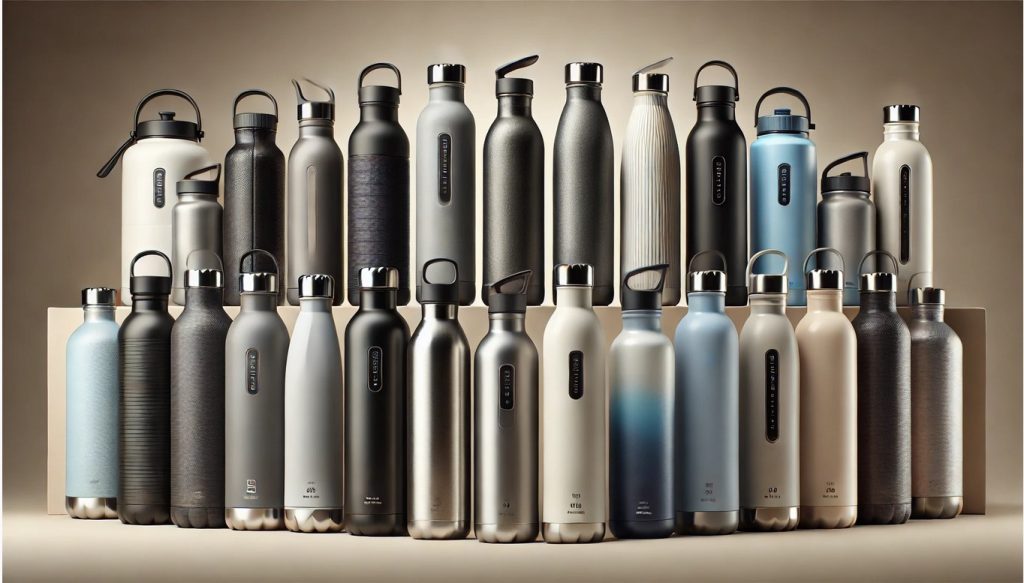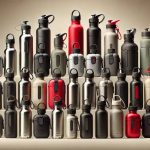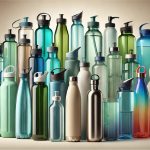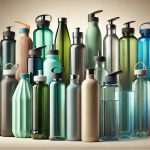Staying hydrated is vital for overall health and wellness, especially when you’re on the go. Whether you’re hiking through rugged terrain, heading out for a long commute, or working at your desk, the temperature of your water can make a significant difference in your experience. This is where temperature-controlled water bottles come in. These bottles are designed to maintain the ideal temperature of your beverage for extended periods, ensuring that your drink stays refreshing and enjoyable, no matter the conditions outside.
What Are Temperature-Controlled Water Bottles?
Temperature-controlled water bottles, also known as insulated or thermally-controlled bottles, are specially designed to maintain the temperature of your beverages—whether hot or cold—for hours. They are built with materials and technologies that reduce the transfer of heat, ensuring that the contents stay at the desired temperature. These bottles are ideal for people who are constantly on the move, as they provide a convenient way to carry beverages at the perfect temperature throughout the day.
How Temperature-Controlled Bottles Work
Temperature-controlled bottles typically work through a combination of insulation and advanced technology. The two main types of insulation found in these bottles are vacuum insulation and double-wall insulation, both of which are effective at preventing heat exchange.
- Vacuum Insulation: Vacuum insulation involves a layer of air being sealed between two walls of the bottle, creating an insulating barrier. This vacuum seal helps prevent the heat from escaping (for hot beverages) or entering (for cold beverages). This system is one of the most efficient for maintaining temperatures.
- Double-Wall Insulation: Double-wall insulation involves two layers of material, usually metal or plastic, that are separated by an insulating material. This system works similarly to vacuum insulation but may not be as effective in extreme conditions.
The high-performance insulation in these bottles is what makes them perfect for keeping your drink at the optimal temperature for an extended period. Whether you’re dealing with a cold winter day or the sweltering heat of summer, temperature-controlled bottles ensure that your beverage stays at the temperature you desire.
Types of Temperature-Controlled Water Bottles
Temperature-controlled water bottles come in various types and designs, each suited to different preferences and needs. These bottles are made from a range of materials and come with features tailored to particular activities, such as outdoor adventures or everyday commuting. Below are the most common types of temperature-controlled bottles on the market.
Stainless Steel Insulated Bottles
Stainless steel is a popular choice for temperature-controlled bottles due to its durability, strength, and excellent insulation properties. Stainless steel insulated bottles are known for keeping beverages cold for up to 24 hours or hot for 12 to 18 hours, depending on the brand and design.
Features of Stainless Steel Insulated Bottles
- Double-Walled Construction: Most stainless steel insulated bottles use double-walled construction with a vacuum-sealed layer between the walls to keep the temperature stable.
- Durable: Stainless steel is a robust material, making these bottles resistant to dents, corrosion, and impact.
- Easy to Clean: Stainless steel bottles are easy to clean and resistant to odor retention, making them ideal for use with a variety of beverages.
- BPA-Free: Stainless steel is naturally free of BPA and other harmful chemicals commonly found in plastic bottles.
Common Uses of Stainless Steel Insulated Bottles
- Outdoor Adventures: Stainless steel bottles are perfect for hiking, camping, and long trips due to their durability and ability to keep drinks at the right temperature.
- Commuting: They are often used by commuters who need a bottle that can maintain the temperature of their coffee or cold drinks during the journey.
- Gym: Ideal for keeping water cool during intense workouts or training sessions.
Plastic Insulated Bottles
Plastic insulated bottles are another popular choice, offering a lighter, more affordable option compared to stainless steel. While they might not offer the same level of durability, they still provide solid insulation to keep drinks at the desired temperature.
Features of Plastic Insulated Bottles
- Lightweight: Plastic bottles are generally lighter than their stainless steel counterparts, making them easier to carry around.
- Affordable: Plastic bottles are usually more budget-friendly compared to other materials like stainless steel or glass.
- Color Variety: Plastic bottles often come in a wider range of colors and designs, allowing users to choose a bottle that fits their personal style.
Common Uses of Plastic Insulated Bottles
- Casual Everyday Use: These bottles are perfect for daily hydration, such as carrying water to work or school.
- Sports: Lightweight and easy to handle, plastic bottles are ideal for athletes looking for a convenient way to hydrate during sports events or outdoor activities.
Glass Insulated Bottles
Glass insulated bottles are a more eco-conscious option, offering a chemical-free experience for those who prefer a natural drinking experience. They are generally used with an outer layer of protection, such as a silicone sleeve, to provide insulation and prevent breakage.
Features of Glass Insulated Bottles
- Non-Toxic: Glass does not leach chemicals into the beverage, making it a safe and healthy choice for carrying water or tea.
- Aesthetic Appeal: Glass bottles have a sleek, elegant design, appealing to those who value aesthetics along with functionality.
- Easy to Clean: Glass bottles are easy to clean and don’t absorb odors or stains like plastic can.
Common Uses of Glass Insulated Bottles
- Health-Conscious Individuals: Glass bottles are perfect for people who prefer drinking from a non-toxic container.
- Office or Home Use: These bottles are often used at the office or home, providing a stylish and practical solution for keeping drinks at the ideal temperature.
Hydration Reservoirs with Temperature Control
Some hydration reservoirs (or hydration bladders) are equipped with temperature control features. These types of bottles are often used in outdoor activities like hiking, running, or cycling, where having easy access to water is essential.
Features of Hydration Reservoirs with Temperature Control
- Hands-Free Hydration: Hydration reservoirs allow you to drink without having to stop or hold onto a bottle, making them perfect for active individuals.
- Insulated Reservoir: Some hydration reservoirs are designed with an insulated sleeve or cover to help maintain the temperature of the water.
- Ergonomic: These bottles are designed to fit easily into backpacks and feature a long hose that you can sip from while on the move.
Common Uses of Hydration Reservoirs with Temperature Control
- Outdoor Activities: Ideal for hikers, runners, cyclists, and athletes who need easy access to water without stopping their activity.
- Long Trips: Perfect for multi-day trips or long-distance hikes where staying hydrated is critical.
Materials Used in Temperature-Controlled Water Bottles
The material used in temperature-controlled water bottles plays a critical role in determining their performance, durability, and overall functionality. Different materials offer various benefits, and understanding the properties of each can help you choose the best option for your needs.
Stainless Steel
Stainless steel is the material of choice for many high-quality temperature-controlled bottles due to its excellent insulation properties and long-lasting durability. The use of double-wall vacuum insulation helps to keep the contents hot or cold for an extended period.
Benefits of Stainless Steel
- Superior Insulation: Stainless steel bottles often provide the best thermal performance, keeping drinks cold or hot for longer periods.
- Durability: Stainless steel is extremely durable, resistant to rust, corrosion, and impacts.
- BPA-Free: Stainless steel is naturally free from harmful chemicals like BPA, which is commonly found in some plastics.
Considerations
- Weight: Stainless steel bottles tend to be heavier than plastic or glass bottles.
- Cost: High-quality stainless steel bottles can be more expensive compared to plastic bottles.
Plastic
Plastic is lightweight and affordable, making it a popular option for many insulated bottles. However, not all plastics are created equal, so it is important to choose BPA-free plastic options for health and safety reasons.
Benefits of Plastic
- Lightweight: Plastic bottles are lighter than stainless steel and glass, making them easier to carry, especially for daily use.
- Cost-Effective: Plastic is generally less expensive than stainless steel or glass bottles.
- Variety of Designs: Plastic bottles come in many different colors, sizes, and styles, offering more design flexibility.
Considerations
- Durability: Plastic bottles may not be as durable as stainless steel or glass and may crack or scratch more easily.
- Chemical Concerns: If not BPA-free, plastic can leach harmful chemicals into your water, especially when exposed to heat.
Glass
Glass bottles are an eco-friendly option, offering a safe, chemical-free drinking experience. They are often encased in protective silicone sleeves for added insulation and durability.
Benefits of Glass
- Non-Toxic: Glass is free from chemicals like BPA and phthalates, making it the safest option for those concerned with potential health risks.
- Pure Taste: Glass does not affect the taste of your drink, providing a cleaner, purer drinking experience.
- Aesthetic Appeal: Glass bottles offer an elegant, premium look and feel, making them a stylish choice for many users.
Considerations
- Fragility: Glass bottles can be fragile and may break easily if dropped.
- Weight: Glass bottles are typically heavier than plastic, which can make them less portable.
Silicone
Silicone is a flexible, durable material that is often used in collapsible or outer protective sleeves for temperature-controlled bottles. It is heat-resistant, non-toxic, and often used in combination with other materials like stainless steel or plastic.
Benefits of Silicone
- Flexible: Silicone is flexible and durable, which makes it ideal for protective covers or collapsible designs.
- Non-Toxic: Silicone is BPA-free and safe for food and beverages.
- Durable: Silicone is resistant to wear and tear and can withstand extreme temperatures.
Considerations
- Insulation: While silicone provides durability and flexibility, it is not as effective as stainless steel in maintaining the temperature of drinks.
- Cleaning: Silicone may require more thorough cleaning to avoid retaining odors, especially when used with flavored drinks.
Factors to Consider When Choosing a Temperature-Controlled Water Bottle
When selecting the best temperature-controlled water bottle for your needs, several factors should be taken into account. Here are some key considerations to keep in mind:
Insulation Efficiency
One of the most important factors is how well the bottle can maintain the temperature of your beverage. The quality of the insulation and the bottle’s design, including whether it uses double-wall vacuum insulation or other technologies, will determine how long your drink stays hot or cold.
Size and Capacity
Consider how much water you need to carry and how much space you have in your bag or backpack. Bottles come in a variety of sizes, from small 12 oz models to larger 32 oz or 40 oz options. Think about your hydration needs and choose a size that is suitable for your daily activities.
Durability
The material of the bottle plays a significant role in its durability. Stainless steel and glass bottles tend to be more durable and resistant to impacts than plastic bottles. If you plan to use the bottle for outdoor activities or travel, you’ll want to select one that can withstand rough handling.
Ease of Use
Look for bottles that are easy to open, drink from, and clean. Features such as a wide mouth for easy filling and cleaning, a flip-top lid, or a built-in straw for easy sipping can make using the bottle more convenient.
Weight and Portability
If you plan on carrying the bottle for long periods, such as during hikes or daily commutes, consider its weight and portability. Stainless steel bottles tend to be heavier than plastic bottles, so if weight is a concern, opt for a lighter material like plastic or silicone.
Price and Value
While temperature-controlled bottles may have a higher initial cost compared to regular plastic bottles, their long-term benefits make them a worthwhile investment. Consider the quality, features, and durability of the bottle to assess its value.
Design and Aesthetic
For many people, the design and aesthetic appeal of the bottle are important considerations. Choose a bottle that matches your personal style and preferences. Many brands offer a range of colors, sizes, and designs to suit different tastes.







